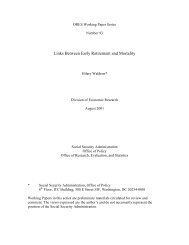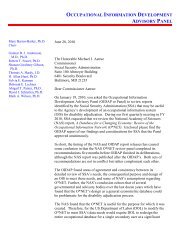Selected Abbreviations—continuedOASIPIASSAOld-Age and Survivors Insuranceprimary insurance amount<strong>Social</strong> <strong>Security</strong> Administrationunderstand how the changes in the system are shapingthe retirement behavior of older Americans.Our analysis finds evidence of significant effectsof the removal of the earnings test, with a large andsignificant short-run effect of abolishing the test on theclaiming behavior of older Americans and evidence ofa significant and much longer-lived effect on the compositionof benefit claimers and their levels of benefitsreceived after age 65. We also find sizable effects inthe levels of benefits received by early claimers, especiallymen, as a result of the increase in the FRA, buta hardly noticeable effect of the increases in the DRC.The results on claiming behavior are very similar tothose discussed in recent articles by Song and Manchester(2007a, 2007b, and 2007c) using the same databut different empirical strategies. As far as we know,we are the first to analyze the trends in benefit receiptduring the period from 1994 through 2004 and connectthem with the reforms to the system.Our findings should encourage researchers to usethe public-use data provided by the <strong>Social</strong> <strong>Security</strong>Administration (SSA). This data source can complementmore traditional analyses using household-leveldata and provide useful benchmarks for researchersmodeling retirement behavior using advanced econometricand computational methods of analyses.This data source, although highly reliable for thestudy of claiming behavior, has the disadvantage ofnot allowing us to control for the usually long list ofsociodemographic and socioeconomic variables orto analyze other relevant variables of interest such aslabor supply. This means that there is potentially alarge amount of heterogeneity, which in other studieswould be observable, but in this case remains unobservablefor us. However, we find that our ability toaccess detailed information on claiming behavior andthe level of benefits resulting from that benefit applicationallows us to provide a realistic and surprisinglyilluminating picture of how changes in the system arequite likely affecting claiming behavior, which suggesta large explanatory power intrinsic in accuratelyobserving the self-selection into claiming and theimportance of properly understanding the complex setof incentives involved in people’s decision to apply forretirement benefits at a given age.It is important to highlight that the nature of theanalysis we perform does not allow us to guaranteethat the patterns we observe in claiming behavior andlevel of benefits received are solely the product of thepolicy changes. In terms of identification, other macroeffects and also cohort effects could be driving, atleast in part, the results. Given the lack of plausiblereasons for the large differences over time and acrosscohorts that could be responsible for the particular patternof decisions and outcomes we observe, we believethe policy changes are the most natural and appealingexplanation. 2A discussion of the incentive structure provided by<strong>Social</strong> <strong>Security</strong>’s OASI system follows. Next, we giveinformation about the data set used in the analysis andthen report our main findings. Our conclusions aregiven in the last part of the article.Retirement Benefits: An OverviewPublic pensions are a major income source for olderAmericans, and under the OASI program during2008, SSA paid about $509.3 billion to almost 42 millionbeneficiaries (Board of Trustees 2009). Giventhe importance of <strong>Social</strong> <strong>Security</strong>, it is not surprisingthat the discussion over the need of reforms to thesystem has gone on for a long time. In fact, the 1983Amendments to the <strong>Social</strong> <strong>Security</strong> Act were meantto solve short-term financial imbalances and the moreserious long-run financial crisis that <strong>Social</strong> <strong>Security</strong>was headed toward. The reforms resulting from thoseamendments have started to take effect during the pastfew years, as the discussion on possible additionalreforms continues.<strong>Social</strong> <strong>Security</strong> provides fairly complex incentivesthat undoubtedly affect the labor supply and benefitclaiming behavior of individuals starting at the earlyretirement age and continuing until age 70. 3 Retirementbenefits at all ages are intimately linked to aperson’s earnings history, but also to a fairly largenumber of provisions that compute the benefits aperson receives as a function of the following: 4• the person’s 35 highest years of earnings, conditionalon having at least 40 quarters of coveredearnings, which loosely translates into 10 years ofpaid work. Any years without covered earnings gointo the formula as a zero.78 <strong>Social</strong> <strong>Security</strong> Bulletin • Vol. 69 • No. 3 • 2009
• the indexing factors to adjust past earnings to currentwage levels. These factors reflect the growth inaverage earnings in the economy over the years.• the progressive formula, which uses bend points(indexed to the growth rate in the average wageindex and therefore change every year) and marginalreplacement rates (fixed) by indexed-earningsbrackets to compute the primary insurance amount(PIA). The latter is the level of benefits a personreceives if he or she claims benefits at the FRA.• the actuarial reduction factor (ARF), which determinesthe reduction in benefits that individuals faceif they claim benefits before attaining the FRA.This reduction factor depends on the person’s FRA.For those who claimed benefits upon attainingage 62 in 2008, the FRA was 66 and the reductionfactor was 0.75. The reduction factor will be 0.7for earliest entitlement when the FRA increasesto age 67 for people born in 1960 or later. Giventhat individuals can claim benefits in any monthafter they reach age 62, the reduction factor is 5/9of 1 percent during the first 36 months before theFRA, and 5/12 of 1 percent for the months beyondthe first 36. The benefit reduction is permanentunless benefits are reduced because of the earningstest. In that case, as explained later, there will be arecalculation of this factor when the person reachesthe FRA.• the DRC, which determines the upward adjustmentof benefits if individuals claim after the FRA. Forthose born in 1943 or later, it is 2/3 of 1 percentfor each month up to age 70. For those born before1943, it ranges from 11/24 to 5/8 of 1 percent permonth, depending on their birth year. In fact, theAmendments of 1983 included, among other measures,a phased increase in the DRC, with the clearobjective of fostering work after the FRA. TheDRC started to increase (from an initial annualizedvalue of 3 percent) by half a percentage point forthose attaining age 65 in the 1990–1991 period, andit has increased by half a percentage point every2 years, reaching 8 percent for the cohort that willreach age 65 in 2008―the level at which it will stayuntil further reform changes it.• the earnings levels between the time the personclaims benefits and reaches the FRA, in order toapply the earnings test and withhold benefits ifnecessary. Therefore, the exempt amounts matterand they are different in the period between theearly retirement age and the year the person reachesthe FRA, and thereafter. 5• the number of monthly checks withheld becauseof the earnings test. This function is used once theperson reaches the FRA to compute the upwardadjustment to the ARF to compensate for the withheldbenefits. 6The concept of actuarial fairness is underlying allthese factors and especially those that require adjustmentsthat are due to early or late (with respect to theFRA) claiming of benefits. Although the application ofthis concept faces practical difficulties given how longago some of these adjustment factors were decidedand the reasons for them, the idea is that an individualwith a life expectancy at the average of the populationshould be indifferent between claiming benefits earlyat a reduced rate and claiming them at any point afterthat, assuming all individuals have the same subjectivediscount rate or that there is a distribution ofdiscount rates, which maps the mortality probabilitiesin the population. 7 In budgetary terms it means that noadditional cost to the system arises on account of early(or late) retirement. 8At the individual level, however, it should comeas no surprise that empirically we will observe inour analysis that actuarial fairness, although it goesa long way in explaining disparities in benefit levels,does not perfectly account for the different benefitclaiming behavior of older Americans, even when weobserve population data that allows us to use law-oflarge-numbersarguments to approximate aggregatebehavior. The reason is that there are many other factorspotentially affecting claiming behavior, some ofthem relatively well understood and others the objectof current and future research. In part, this articletries to analyze how substantial deviations from thoseaverages can be linked to claiming behavior and thelevel of benefits of those claiming at different ages.Open questions should come as no surprise giventhe short time since some of these changes startedto take place and the fact that these changes are stilltaking place. These complications are exemplified bythe three types of policy changes we focus on in thisarticle: (1) the changes in the FRA, which affect thereduction factors when individuals claim early; (2) thechanges in the adjustments that are due to late claimingof benefits; and (3) the removal of the earnings testfor those above the FRA. The administrative publiclyavailable extract of the MBR can be used to characterizesome of the consequences of these changes,and it provides insightful discussions of how possiblereforms will most likely affect the claiming behaviorof older Americans.<strong>Social</strong> <strong>Security</strong> Bulletin • Vol. 69 • No. 3 • 2009 79
- Page 1 and 2:
Social SecuritySocial SecurityBulle
- Page 3:
Social SecurityBulletin Vol. 69, No
- Page 6 and 7:
Perspectives77 An Empirical Study o
- Page 8 and 9:
Selected Abbreviations—continuedM
- Page 10:
within the next few years (Aglira 2
- Page 14 and 15:
coverage varies significantly by ra
- Page 16 and 17:
non-Hispanic white, and college edu
- Page 18 and 19:
same groups (Table 6). For the last
- Page 20 and 21:
from DB to DC pensions is accelerat
- Page 22 and 23:
Table 8.Percent of individuals who
- Page 24 and 25:
not necessarily the largest gains a
- Page 26 and 27:
shoring-up DB plans before those pl
- Page 28 and 29:
Table B-1.Percent change in mean pe
- Page 30 and 31:
Table B-3.Percent of individuals wh
- Page 32 and 33:
ReferencesAaronson, Stephanie, and
- Page 35 and 36: Social Security Administration’s
- Page 37: Chart 1.Historical expansion of Soc
- Page 40 and 41: self-employment information for the
- Page 42 and 43: (Cronin 1985). The final earnings r
- Page 44 and 45: prior to 1950, first year of earnin
- Page 46 and 47: average indexed monthly earnings (A
- Page 48 and 49: 13For an explanation of how the sel
- Page 50 and 51: Kopczuk, Emmanuel Saez, and Jae Son
- Page 53 and 54: Occupations of SSI Recipients Who W
- Page 55 and 56: on the differences between the occu
- Page 57 and 58: prediction models. Table A-1 lists
- Page 59 and 60: Occupational Distributions of theEm
- Page 61 and 62: similar, only 4 percent of the popu
- Page 63 and 64: Table 5.Estimated occupational dist
- Page 65 and 66: Table 7.Predicted Herfindahl-Hirsch
- Page 67 and 68: Table 9.Estimated occupational dist
- Page 69 and 70: Table 11.Average annual wages of wo
- Page 71 and 72: Table A-2.Means and standard errors
- Page 73 and 74: Table A-3.Coefficients and standard
- Page 75 and 76: Table A-3.Coefficients and standard
- Page 77 and 78: Table A-3.Coefficients and standard
- Page 79 and 80: management, professional, and relat
- Page 81: Stapleton, David C., Nanette Goodma
- Page 86 and 87: The 1983 Amendments to the Social S
- Page 88 and 89: Chart 1.Proportion of new claimants
- Page 90 and 91: Table 4.The evolution of the ARF an
- Page 92 and 93: for the test of equality of means b
- Page 94 and 95: Table 8.Average monthly Social Secu
- Page 96 and 97: in the chart, especially for men, t
- Page 98 and 99: 6This is a very important character
- Page 100 and 101: Benítez-Silva, Hugo, Berna Demiral
- Page 103 and 104: OASDI and SSI Snapshot andSSI Month
- Page 105 and 106: Monthly Statistical Snapshot, Augus
- Page 107 and 108: Table 2.Recipients, by eligibility
- Page 109 and 110: SSI Federally Administered Payments
- Page 111 and 112: Table 7.Average monthly payment, by
- Page 113: Awards of SSI Federally Administere
- Page 116 and 117: Copyright—Authors are responsible
- Page 119 and 120: Program Highlights, 2009Old-Age, Su








